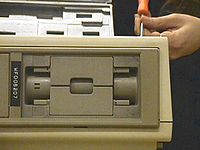Difference between revisions of "RX50 dual-diskette drive"
From Computer History Wiki
m (Re-classify) |
|||
| (8 intermediate revisions by 3 users not shown) | |||
| Line 1: | Line 1: | ||
| − | [[Image:rx50.jpg|thumb| | + | {{Infobox Disk drive |
| + | | name = RX50 | ||
| + | | manufacturer = [[Digital Equipment Corporation|DEC]] | ||
| + | | capacity = 400 KB (per floppy) | ||
| + | | transfer rate = 250K bits/sec | ||
| + | | average access time = 164 msec | ||
| + | | rpm = 300 | ||
| + | | revolution time = 100 msec | ||
| + | | one track seek = 6 msec | ||
| + | <!-- | average seek = | ||
| + | | maximum seek = --> | ||
| + | | surfaces = 1 (2 floppies per RX50) | ||
| + | | number of heads = 1 (per floppy) | ||
| + | | tracks = 80 (per floppy) | ||
| + | | sectors = 10 (soft) | ||
| + | | bytes per sector = 512 | ||
| + | | tracks per inch = 96 | ||
| + | | density = 5576 flux changes/inch | ||
| + | | recording method = [[Modified Frequency Modulation|MFM]] | ||
| + | | start time = 500 msec | ||
| + | | physical size = 3.25" x 5.75" x 8.5" | ||
| + | | weight = 4.8 lb | ||
| + | | power consumption = 4.2W (idle)<br>17.5W (active) | ||
| + | }} | ||
| + | |||
| + | [[Image:rx50.jpg|thumb|left|200px|RX50]] | ||
| − | 5.25" floppy drive, | + | The '''RX50 dual-diskette drive''' is a 5.25" full height [[floppy disk]] drive from [[Digital Equipment Corporation|DEC]]. It uses [[Modified Frequency Modulation|MFM]] encoding, and holds 400 KB per floppy. |
| − | = 4.3 BSD disktab = | + | It is supported by the following DEC [[QBUS]] MFM disk controllers: |
| + | |||
| + | * [[RQDX1/RQDX2 MFM Disk & Floppy QBUS Controllers|RQDX1]] | ||
| + | * [[RQDX1/RQDX2 MFM Disk & Floppy QBUS Controllers|RQDX2]] | ||
| + | * [[RQDX3 MFM Disk & Floppy QBUS Controller|RQDX3]] | ||
| + | |||
| + | There are two controllers for other buses: | ||
| + | |||
| + | * [[RUX50]] for the DEC [[UNIBUS]] | ||
| + | * [[RCX50]] for the DEC [[CTI BUS]] | ||
| + | |||
| + | The DEC order number for RX50 floppies is '''RX50K'''. | ||
| + | |||
| + | ==4.3 BSD disktab== | ||
<pre> | <pre> | ||
rx50|RX50|DEC RX50:\ | rx50|RX50|DEC RX50:\ | ||
| Line 10: | Line 48: | ||
</pre> | </pre> | ||
| − | {{stub}} | + | {{semi-stub}} |
| + | |||
| + | ==External links== | ||
| + | |||
| + | * [http://bitsavers.org/pdf/dec/disc/rx50/ rx50] - documentation at [[Bitsavers]] | ||
| + | * [http://bitsavers.org/pdf/dec/rainbow/EK-PC100-TM-001_Rainbow_100_Technical_Manual_May84.pdf Rainbow 100 Technical Manual] (EK-PC100-TM-001) - the RX50 is covered in detail here, in Chapter 6 (pp. 218-255 of the PDF) | ||
| + | * [http://bitsavers.org/pdf/dec/rainbow/RX50_FAQ.txt Frequently Asked Questions File for RX50 Users] | ||
| + | * [http://www.vaxarchive.org/hardware/rx50.html The RX50 FAQ] | ||
| + | * [https://rc.xqwv.org.uk/2014/rx50.html RX50 technology] | ||
| + | |||
| + | [[Category: DEC Floppy Disk Drives]] | ||
Latest revision as of 23:16, 12 October 2024
| RX50 | |
| Manufacturer: | DEC |
|---|---|
| Capacity: | 400 KB (per floppy) |
| Transfer Rate: | 250K bits/sec |
| Average Access Time: | 164 msec |
| Revolutions per Minute: | 300 |
| 1/2 Revolution Time: | 100 msec |
| One Track Seek Time: | 6 msec |
| Total Surfaces: | 1 (2 floppies per RX50) |
| Number of Heads: | 1 (per floppy) |
| Tracks per Surface: | 80 (per floppy) |
| Sectors per Track: | 10 (soft) |
| Bytes per Sector: | 512 |
| Tracks per Inch: | 96 |
| Density: | 5576 flux changes/inch |
| Recording Method: | MFM |
| Start Time: | 500 msec |
| Physical Size: | 3.25" x 5.75" x 8.5" |
| Weight: | 4.8 lb |
| Power Consumption: | 4.2W (idle) 17.5W (active) |
The RX50 dual-diskette drive is a 5.25" full height floppy disk drive from DEC. It uses MFM encoding, and holds 400 KB per floppy.
It is supported by the following DEC QBUS MFM disk controllers:
There are two controllers for other buses:
The DEC order number for RX50 floppies is RX50K.
4.3 BSD disktab
rx50|RX50|DEC RX50:\ :ty=removable:ns#10:nt#1:nc#80:\ :pa#800:ba#4096:fa#512:
External links
- rx50 - documentation at Bitsavers
- Rainbow 100 Technical Manual (EK-PC100-TM-001) - the RX50 is covered in detail here, in Chapter 6 (pp. 218-255 of the PDF)
- Frequently Asked Questions File for RX50 Users
- The RX50 FAQ
- RX50 technology
